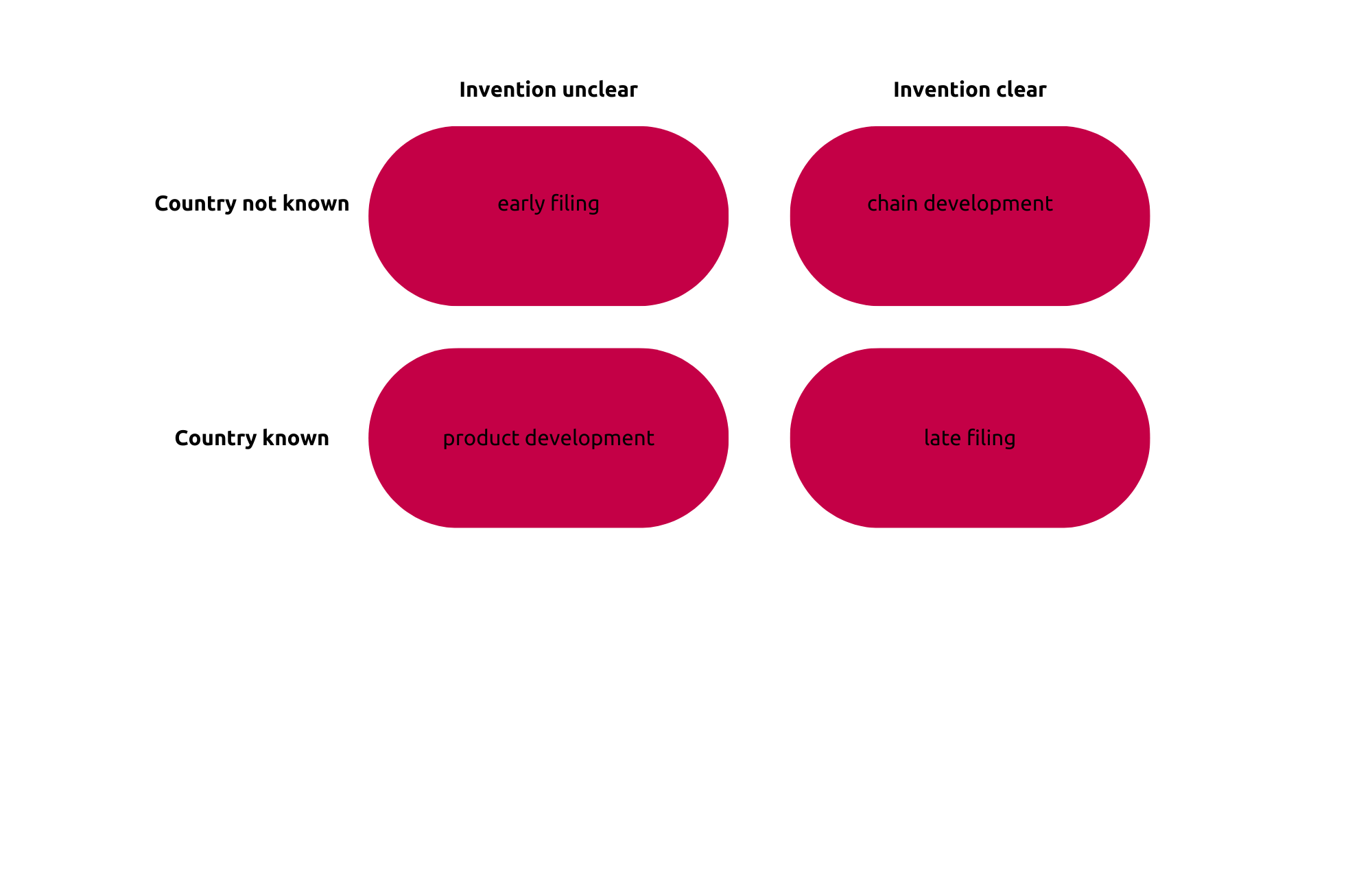
Apart from the question of “what” needs to be protected with a patent, other essential questions when applying for patents are “where” and “when” this should be done. This blog post will define strategies to help you decide where and when to file your patent application.
It is fairly common for a successful invention to be patented in several countries, for example to protect several sales markets. The patents in these countries usually come after a so-called first filing of a patent application. To choose an organization for a first filing, it is useful to know the countries in which you eventually want to have patent protection.
It is also important to properly estimate potential future changes to your invention. Changes to the invention can lead to a filed patent application becoming less relevant or worthless.
Four strategies
Using the above information, four strategies for filing a patent have been formulated, which will be explained below.

Strategy 1: Early filing
Applying for a patent at an early stage of an innovation is particularly important if you expect that a competitor could beat you to it. A good indicator of this, for example, is the attention paid to patents in the sector in question. After all, a patent is granted to the first to apply for it, not to the first to create the invention and keep it secret.
A risk of filing a patent application early is that it is no longer relevant at a later stage, for example because the invention has changed or the product does not reach the market. Therefore, if it is not yet clear in which country a patent will be of value in the future, it might be better to keep the costs for a first filing as low as possible.
The costs for a first filing consist of the costs for the organization chosen to deal with the patent application, plus any costs for a patent drafter such as a patent attorney. Given the relatively low costs compared to the EPO and WIPO, the Netherlands Patent Office (OCNL) is an attractive option for a first filing in this case.
The costs for drafting a patent application are usually much higher than the filing costs. Searching for a patent attorney who is well-acquainted with the subject matter or who works in a country with relatively low labour costs may be an attractive way to keep costs down.
Strategy 2: Chain development
In the event of a radical innovation or diversification of business activities, it may be the case that the invention is clear before it is known in which countries a patent for the invention could potentially be useful. In particular, if it is not expected that another party will file a patent for the same invention, it may be interesting to delay a first filing of a patent.
To develop a new supply chain or sales market, it may be necessary to share the invention with third parties. As a result, it is possible to postpone a first filing to a limited extent. Sharing the invention in a supply chain while maintaining secrecy is often possible, but not without risk. However, maintaining secrecy does not offer a solution for a successful patent strategy that focuses on consumer markets.
If the focus is on developing the chain, it is important to have options for a patent in as many countries as possible at the lowest possible costs. It is possible to obtain an option for more than 150 countries by filing an International patent application via WIPO. This option has a term of at least two and a half years after the first filing. A more limited option for more than 40, mostly European, countries is obtained by filing a European patent application with the EPO.
As is customary for options, it is necessary to decide whether to exercise the option before the term expires. For an International patent application, this means the actual commencement of procedures in countries or for regions such as Europe. Given the costs of these procedures, it is advisable to develop the chain before the option expires.
Strategy 3: Product development
A situation where the chain is known but the invention is not yet fully developed is quite common in the case of incremental innovations. This is the case, for example, if existing products are further developed. Applying for a patent at an early stage is attractive in particular if there is strong competition and innovations in rapid succession.
In contrast to the early filing as explained above, it is possible in the case of product development to choose a country where the invention must be protected in any case. As this is done at a relatively early stage, this is preferably a country with a relatively large impact on the supply chain or sales market, where it is possible to apply for a patent at acceptable costs.
If the invention is completed within 12 months of the first filing, patent applications can be filed in the selected countries. Alternatively, it is possible to choose a European or International patent application in order to thus reduce the costs over the short term. The costs for the individual countries are then incurred at a later stage. However, the total costs do increase in the case of this latter option.
Strategy 4: Late filing
Applying for a patent at a late stage of development is by far the most attractive scenario. During the course of development, risks are scaled back and it becomes clear which countries are important for a patent. Unfortunately, in view of the competition, it is not always possible to keep an invention secret for so long.
Should you find yourself in this fortunate position, the total costs for applying for patents can be reduced by applying for a patent directly in the countries chosen. If there is a relatively high degree of uncertainty regarding market demand, a European or International patent application may still be attractive in order to reduce the costs over the short term.
An additional advantage of a relatively late first filing is that it is possible to get the maximum benefits from a patent. After all, the life of a patent is limited to a maximum of 20 years. A patent application that is filed too early can drastically shorten the useful period in the absence of market introduction.
Conclusion
It strikes me that the term of two and a half years for an International patent application is often on the short side. Particularly if the supply chain still needs to be developed, the option often expires before even one product is sold. In my opinion, this is often the result of focusing too intently on the invention and therefore leaving it too late to establish a supply chain.
As is the case with many investments, the costs will come before the benefits. One disadvantage of patent protection that is often mentioned is that the costs come a very long way before the benefits. It is possible that one of the above scenarios will be able to soften the blow.
Please contact one or our attorney's
Contact